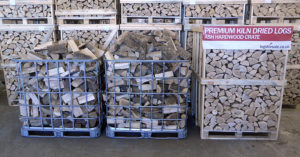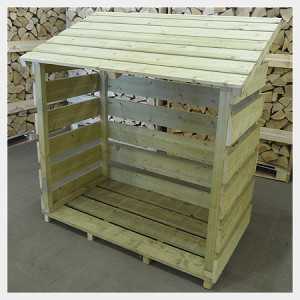The main reason why to buy and use kiln dried logs is that you always know what you’re getting – logs that have being placed in a large heat and humidity controlled kiln and left for days until the moisture content reaches the desired levels – normally less than 20%. The incredibly high temperatures of the kiln combined with the low humidity draws the moisture out of the logs quickly and effortlessly.
When buying seasoned logs, you have to take the processors word that they’re “seasoned”, which is an ambiguous term which unfortunately means very little. They could have air-dried for 6 months or 3 years, and you’ll never know unless you test the logs yourself with a moisture meter before purchasing – including splitting the logs and checking the internal moisture content, which can differ far greatly in seasoned logs due to the nature of traditional air-dried logs; they don’t release their internal moisture as easily as when kiln dried, and logs that measure 20% on the outside could be 40% and wet on the inside.
Kiln dried logs won’t damage your stove or flue lining
Most seasoned logs from local suppliers start at 25% and upwards to 40%, depending on how long they have been left to dry out, and over time will cause significant damage to your stove and flue lining, causing high levels of creosote and tar build-up. Very well seasoned logs that are below 20% are extremely hard to find, as keeping up with demand in a market that’s growing so rapidly due to the popularity of wood burners is difficult for traditional suppliers to accomplish, hence the growing demand for ready to burn kiln dried logs.
One kiln dried log is worth two seasoned logs
Kiln dried logs carry a higher price than traditional air-dried logs due to the higher efficiency and quality that they offer – so much so that one kiln dried log can provide the same amount of heat as 2-3 regular seasoned logs – meaning you only need 1 log on your stove at any time for excellent heat output; this is where the true value of kiln dried logs are.
They are always available all-year round and ready to burn
Because sellers of kiln dried logs only need to hold enough stock to keep up with current demand, it’s far easier to manage stock levels and stock can be ordered in from producers within weeks and not years. This means no matter what month or season we’re in, even February when almost every traditional supplier has run out, you can always guarantee sellers of kiln dried logs will have stock available for you if you find yourself running low near the end of the season.
View our kiln dried logs to see all of our buying options.






 When directing to the payment form, there must be a padlock or security symbol in your address bar confirming the credit card details you enter are only being transferred to the payment provider themselves (such as SagePay), and not to pass through the suppliers website. This ensures your vital details are encrypted and you can be confident they’re safe.
When directing to the payment form, there must be a padlock or security symbol in your address bar confirming the credit card details you enter are only being transferred to the payment provider themselves (such as SagePay), and not to pass through the suppliers website. This ensures your vital details are encrypted and you can be confident they’re safe.

